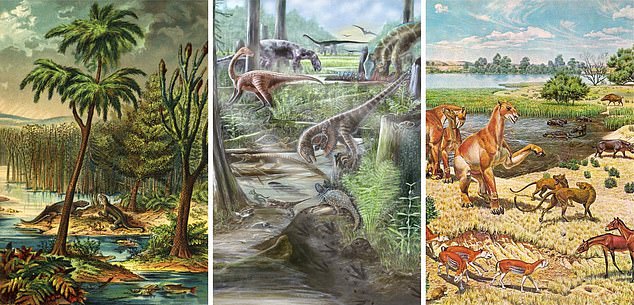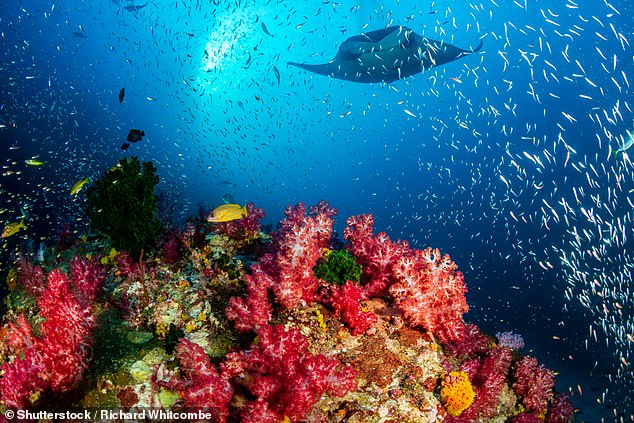- Scientists thought that species’ diversity had increased over millions of years
- New research says that the number of species has increased in sporadic bursts
- Species across ecosystems have now not increased for ‘tens of millions of years’
- The findings could shed light on understanding the effects of falling rates of biodiversity seen across the world today
The diversity of species living on the planet has stayed the same for the 60 million years following the extinction of the dinosaurs, new research suggests. Rapid increases in biodiversity were discovered in the fossil record, followed by plateaus of stability in species’ numbers lasting tens of millions of years.Experts previously thought that biodiversity had steadily increased over time, but researchers now say this is not the case.
The diversity of species living on the planet has stayed the same for the 60 million years following the extinction of the dinosaurs, new research suggests. This artist’s impression shows peaks in biodiversity (left to right) 300, 110 and 15 million years ago. These rapid increases in biodiversity were followed by plateaus of stability in species numbers lasting tens of millions of years.
Scientists from the University of Birminghamanalysed 200 years of finds from 30,000 fossil sites around the globe.They found the average numbers of land vertebrate species across the planet had not increased for tens of millions of years. Their results suggest the creation of new species and extinction rates on land find a natural equilibrium that lasts ‘tens of millions of years’. Lead study authorDr Roger Close said: ‘Scientists often think that species diversity has been increasing unchecked over millions of years, and that diversity is much greater today than it was in the distant past.
‘Our research shows that numbers of species within terrestrial communities are limited over long timescales, which contradicts the results of many experiments in modern ecological communities – now we need to understand why.’Contrary to what you might expect, the largest increase in diversity within land vertebrate communities came after the mass extinction that wiped out the dinosaurs, 66 million years ago, at the end of the Cretaceous period.’Within just a few million years, local diversity had increased to two or three times that of pre-extinction levels – driven primarily by the spectacular success of modern mammals.’
Rich levels of biodiversity has stayed the same for the last 60 million years following the extinction of the dinosaurs, new research suggests. According to a new study the number of species within ecological communities on land has increased only sporadically through time (stock image)
Biodiversity describes the rich diversity of life on Earth, from individual species to entire ecosystems. The term was coined in 1985 – a contraction of ‘biological diversity’ – but the huge global biodiversity losses now becoming apparent represent a crisis equalling and quite possibly surpassing climate change. In the latest study, experts focused on data from land vertebrates dating back to the very earliest appearance of this group nearly 400 million years ago.They found peaks in biodversity 300, 110 and 15 million years ago, followed by plateaus of stability in species numbers lasting tens of millions of years.The new findings sheds light on our understanding the effects of falling rates of biodiversity seen across the world today. The results also suggest that interactions between species, including competition for food and space, limit the overall number of species that can co-exist.
WHY DID THE DINOSAURS GO EXTINCT?
Dinosaurs ruled and dominated Earth around 66 million years ago, before they suddenly went extinct.
The Cretaceous-Tertiary extinction event is the name given to this mass extinction.
It was believed for many years that the changing climate destroyed the food chain of the huge reptiles.
In the 1980s, paleontologists discovered a layer of iridium.
This is an element that is rare on Earth but is found in vast quantities in space.
When this was dated, it coincided precisely with when the dinosaurs disappeared from the fossil record.
A decade later, scientists uncovered the massive Chicxulub Crater at the tip of Mexico’s Yucatán Peninsula, which dates to the period in question.
Scientific consensus now says that these two factors are linked and they were both probably caused by an enormous asteroid crashing to Earth.
With the projected size and impact velocity, the collision would have caused an enormous shock-wave and likely triggered seismic activity.
The fallout would have created plumes of ash that likely covered all of the planet and made it impossible for dinosaurs to survive.
Other animals and plant species had a shorter time-span between generations which allowed them to survive.
There are several other theories as to what caused the demise of the famous animals.
One early theory was that small mammals ate dinosaur eggs and another proposes that toxic angiosperms (flowering plants) killed them off.
Article Credit: Daily Mail


